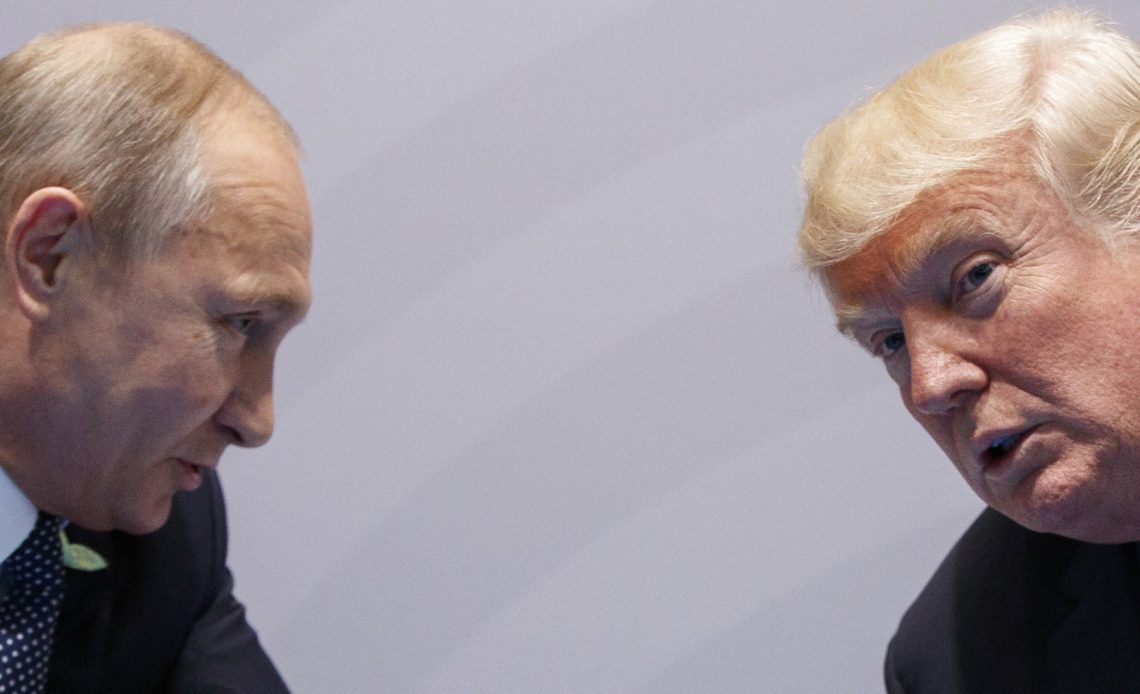
The two-week deadline that President Donald Trump gave Russian President Vladimir Putin to make a peace deal with Ukraine ended Thursday, with Russia showing no signs of stopping the violence as Western leaders pushed for additional security guarantees for Ukraine.
Trump spoke with Ukrainian President Volodymyr Zelenskyy and French President Emmanuel Macron by phone Thursday following a Paris meeting on the so-called “coalition of the willing” to support Ukraine.
Zelenskyy described the call as a “long, detailed conversation about how to push the situation towards peace.”
“The most important thing is pressure, using strong measures, including economic ones, to force an end to the war. The key to peace is depriving the Russian war machine of money and resources,” Zelenskyy said.
Now that Putin has failed again to heed the U.S. president’s deadlines for peace talks, a Ukrainian official told Military Times that the “time is now” to extend economic pressure on Russia and China, which has boosted Russia’s defense industry.
If the Russian economy remains “propped up, then the U.S. steals a chance for transformation in Russia that could be viewed as a sort of USSR collapse 2.0,” the official told Military Times, referring to the fall of the Soviet Union in the late 1980s and early 1990s, which was due in large part to economic pressure from the West, led by then-U.S. President Ronald Reagan.
Russia is currently investing 40% of its state budget in defense, according to NATO.
NATO Secretary General Mark Rutte told reporters Thursday that Western pressure is critical “to make sure that when talks start, the Ukrainian president knows that he has the full backing of the U.S., of Canada, the Europeans — all of us in NATO, but also other countries outside NATO.”
“Let’s not be naïve about Russia. We know what Putin tries to do, and the evidence is there in Ukraine as we speak,” Rutte said.
Overnight, Russia fired 112 strike and decoy drones across Ukraine, according to Ukraine’s Air Force. Kyiv’s air defenses intercepted or jammed 84 of the drones.
Putin told reporters while in Beijing on Wednesday that he is willing to meet with Zelenskyy, but only in Moscow, a non-starter for the Ukrainian president.
‘Coalition of the willing’ promises troops for Ukraine after peace deal
Earlier Thursday, Macron announced that 26 of Ukraine’s allies had pledged to deploy troops in Ukraine’s land, sea or airspace as a “reassurance force” for the war-torn country once fighting ends in the conflict with Russia.
Macron and British Prime Minister Keir Starmer, who lead the group, have insisted that any European “reassurance” force in Ukraine needs the backing of the United States.
The Ukrainian official, speaking to Military Times on condition of anonymity to discuss private diplomatic efforts, worried that boots on the ground would be an expensive security guarantee with untested results.
Trump offers assurances that US troops won’t be sent to defend Ukraine
“Will they engage in a fight if they are attacked?” the official said.
The European-led Sky Shield proposal for Ukraine, in which allies would establish a complete air protection zone to defend against Russian aerial attacks, would be a “stronger” security guarantee for Kyiv, the official added.
As for what Kyiv would like to see from the U.S., the Ukrainian official said she was encouraged that Trump was now able to see the type of enemy Ukraine is facing.
“The meeting in Alaska was a good try,” she said. “Now the whole world can see that Putin is not interested in stopping this war.”
Two Ukrainian officials, speaking on the condition of anonymity to freely discuss security plans, said they hoped Trump would continue to share intelligence with Kyiv and provide weapons to help Ukraine fight off the Russian invasion.
The NATO alliance has taken the lead on coordinating military provisions for Kyiv through its NATO Security Assistance and Training for Ukraine (NSATU) command. By mid-May, the command had trained 25,000 Ukrainians in 2025 and coordinated 1,500 movements of military materiel for Ukraine since late last year, according to a NATO official.
This material now includes American-made weapons purchased from the U.S. by European allies for Ukraine. The latest $825 million purchase by Denmark, the Netherlands and Norway was announced one week ago and will send 3,500 extended-range cruise missiles and GPS navigation kits to Ukraine.
US is selling weapons to NATO allies to give to Ukraine, Trump says
The sales mark a shift from the previous administration’s policy, when the U.S. had led the world in providing military assistance to Kyiv. The Kiel Institute announced last month that Europe has now overtaken the United States in terms of total volume of military aid provided since the start of the war.
The Biden administration sent about $67 billion worth of military weapons and aid to Ukraine to defend their sovereign territory since Russia invaded in February 2022. The money was committed in two ways, either by drawing from U.S. military stockpiles through the presidential drawdown authority (PDA) or by securing future weapons procurements from industry through the Ukraine Security Assistance Initiative (USAI).
About $3.8 billion in approved PDA funds that were appropriated by Congress for Kyiv remained unspent by the beginning of the Trump administration. The Pentagon has so far declined to answer questions about what happened to those funds.
It remains unclear which of the previously promised USAI procurements for Ukraine have been delivered since the start of Trump’s second term. A NASAM air defense missile system that was procured for Ukraine through USAI in 2022 had been scheduled for delivery before the end of fiscal 2025, according to a former defense official.
Speaking on condition of anonymity, Ukrainian and NATO officials stressed that Ukraine’s top need remained air defense, ranging from high-end systems to lower-end weapons, such as Javelin anti-aircraft systems and drones.
Author: Carla Babb
Source: DefenseNews
Reviewed By: Editorial Team



